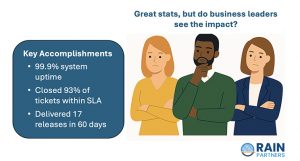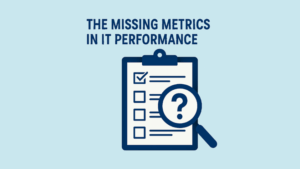Organizational Design for IT: My 5 Best From-the-Trenches Reorganization Tips

You finally decided to go ahead and change your IT organizational structure…and you’re not looking forward to it.
It’s a messy process.
It’s highly political.
It’s unpleasant for everyone.
But since you can no longer avoid reorganization, you at least want to get it done ASAP.
Unfortunately, I hate to say it but that’s just not going to happen.
I’ve worked with plenty of IT leaders who have stated a desire to reorganize quickly and painlessly…but I’ve never seen an IT reorganization proceed quickly and easily.
That’s the bad news.
The good news: I have picked up a few tips, tricks, and best practices that will help you avoid some of the bigger time sinks and headaches surrounding your next reorganization.
Here are a few that have helped me the most as I consult during reorganizations.
Tip #1: Plan a Longer Timeline for Your Reorganization Than You Think It Will Take
Of the many IT leaders I’ve helped through reorganization, very, very few of them took the potential pitfalls in the process seriously enough.
Generally, IT executives—even IT executives who have been through reorganizations and know these processes rarely go according to plan—will talk about their upcoming reorganization like it will be different. They talk as though their reorganization will be a clean and easy process that will take—at most—30 days to complete, without encountering any major problems or bottlenecks.
Each time I’ve heard this, I’ve raised my hand to say, “Sorry, guys, but reorganizing is hard work, and it’s highly unpredictable. It’s not going to happen in a month.”
This is an unpopular statement, but it’s true.
There are predictable reasons why your next reorganization isn’t going to happen in just 30 days (some of which I’ve outlined below), but there are also reasons no one can predict.
A large-scale change in your IT organizational structure involves so many moving parts that you just can’t control it all, or predict how it’s all going to proceed. No matter how well you plan and manage your reorganization, something will probably go wrong that you never saw coming.
The only thing you can predict, with 100% certainty?
That your reorganization process will be unpredictable.
Take the following tips into consideration, and then still budget extra time into your reorganization process to account for all the unknown potential problems waiting for you.
Tip #2: Take Into Account All Your Legal Roadblocks to Reorganizing
Even the best planned and executed reorganization processes can only move as fast as their region’s laws and regulations allow.
And these regional laws and regulations can really slow you down.
Often, we forget about legal issues when planning our reorganization.
A lot of us work in the U.S., and in the U.S. many states have a right-to-work statute that places employment in the hands of the individual and the company.
The result: most people in the U.S. aren’t unionized, and at a compliance level, we tend to believe, “OK, the organizational structure is going to change, so what? Someone’s manager might change, they might start reporting to a new SVP at the top level, but that’s three levels removed from them, so what’s the big deal? No one’s day-to-day life is going to change very much. Let’s just get on with it.”
But unions are still a real consideration in a few states, and they can be very strong in many other countries.
In those countries, there are very real legal repercussions and compliance barriers to consider when drawing out your reorg plan.
For example, in Europe, there are many workers’ unions, national HR policies, and similar other barriers to rapid organizational change.
In many European countries, if you’re going to change someone’s job in any way you have to first go to a workers’ council. Even if you’re not changing someone’s job directly—if you’re just changing the person’s manager or dotted line—you still have to bring your proposed change to a workers’ council. They can take 60 days to give you approval—and that timeline assumes they’re in office and will review your case in a timely fashion.
The net of it: if your reorganization affects workers in countries other than the U.S., expect at least a nine- to twelve-month timeline.
Tip #3: Remember the Human Element of Reorganization
If changing your IT organizational structure only meant drawing up a new org chart, getting it approved by local regulators, and then handing it out, reorganization would take just a few (relatively) pain-free, hands-off months to implement.
But, as anyone who has been through reorganization knows, that just isn’t the case.
The hardline logistical roadblocks to reorganization can produce headaches. The softer human challenges embedded in a reorganization can create migraines.
After all, most people get anxious when they hear change is coming.
When you actually announce your new organizational structure, your people will probably kick up a lot of dust.
Some of your people may feel excited about the professional opportunities your reorganization might bring, but most of your people will likely get nervous.
Managing these nervous people will take a lot of time and hands-on care. You, your reports, and your leaders up and down your organization will have to guide everyone through the new structure, and address the following questions your people are going to ask again and again:
• Am I getting laid off?
• Am I getting promoted?
• Who’s my new boss?
• Do I still have a boss?
• Is my day-to-day work going to change?
And, most of all…
• Why are we even making this change?
It sounds like a lot of questions to answer, and it sounds like a lot of effort to answer them, and, quite frankly, it is. But if you don’t make sure these questions are answered for your people—for each of your people, individually, repeatedly—at least some of your staff will resist the changes you’re trying to implement.
These aren’t answers you can dole out intermittently, in small doses. To get everyone on board with your reorganization, I’ve found it crucial to create a complete timeline of activities surrounding change management and communications.
The work is complex, but the goal of these activities is simple: to help everyone hear, understand, and believe in the change you’re trying to implement while you actually implement it.
If you roll out your change without making sure your people hear, understand, and believe in it, then they might go along with the change, but they won’t live it.
And getting your people to live the change is one of the keys to acquiring its benefits.
Tip #4: Expect the Results of Reorganization to Take Even Longer to Appear Than the Structural Changes
The ability of an IT organization to accept change is slow.
The ability of an IT organization to see the results from that change is even slower.
Every IT leader I’ve helped through reorganization has wondered at least once during the process, “Why did I create so many headaches to bring about this change?”
Because, make no mistake, there will be a point as you’re completing your reorganization, but before you see its results, where you too will wonder why you spent so much time, effort, and money to change things. And you better believe that, if you’re wondering this, your people and your stakeholders are wondering it as well.
And there’s no easy solution to this problem. It takes patience and fortitude, as well as constant reiteration of the reasons why you’re reorganizing and the benefits it will provide, to get yourself, your people, and your stakeholders through these challenging times.
But even though you do have to just get through these down periods, I have learned one trick that can help shorten their length and reduce their damage to morale.
The trick: make the tangible end results of the reorganization as real as possible, as early in the process as possible.
In practical terms, here are a few examples of this:
- Create and disseminate new PowerPoint templates, email signatures, posters, and banners for the new organization. Create these small, tangible details early in the process, and stimulate adoption to make the new organization perceivable in everyone’s daily life before it’s actually arrived.
- Throughout the entire reorganization process, make sure it’s crystal clear what’s supposed to be occurring, who is supposed to be doing it, what the output will be, and how it will bring everyone closer to the new organization. The more concrete and clear the reorganization process, the more concrete and clear the new organization will feel—even before it’s achieved.
- Build proof-of-progress milestones into your rollout plan to create distinct stages of the change in the process. Not only will this give you and your people a continuous sense of achievement, it will help move everyone into the new organizational structure in small, easily-accepted steps, instead of one giant, difficult-to-process leap.
The more visible, tangible, and digestible you can make your new organization and its benefits, the easier it will be to get through those periods where the end feels far off, and the payoff hasn’t yet materialized.
Tip #5: Recruit the Right Partners for Your Reorganization
By now, it should be clear your reorganization will be a larger and longer undertaking than you hoped it would be.
But don’t worry—even though your reorganization is going to be a bigger challenge than you imagined, you also have more support waiting to help you through it than you think.
First, you have the support of your direct reports. In a practical sense, they are the ones who will be implementing your reorganization. It’s up to you to set the vision and strategy, and it’s up to them to implement it.
Specifically, I highly recommend you assign one direct report to oversee the rollout. There’s a lot of micro-detail to manage, not the least of which is maintaining morale, and it’s good to have one person keep track of it all.
And that one person shouldn’t be you. If you try to handle all of your reorganization’s details and micro-details on your own, all while you handle the top-level, big-picture management of your reorganization, you’re going to create an impossible workload for yourself, while at the same time setting yourself up as a big bottleneck slowing everything down.
Do yourself—and your people—a favor. Identify your most detail-oriented direct report and assign overseeing the rollout of your reorganization to that person.
Second, there is an entire non-IT group that can help you roll out your reorganization. They’re called HR, and recruiting their support is counterintuitive to IT.
IT often sees HR as a thorn in its side and a barrier to doing what it wants. The result: HR rarely receives enough respect from IT, and IT almost never asks HR to get involved in its activities.
But HR isn’t there to just get in IT’s way. As a general function, HR is there to protect the larger organization, and that includes the IT group.
The specific role of HR varies from country to country, but during your reorganization HR will often be able to help protect you from wrongful employee action, retention risks, and the other various personnel-related landmines hidden in the reorganization process.
There’s one key to working effectively with HR during your reorganization: develop clarity about what role they will play in the process. In general, HR isn’t going to help you project-manage your reorganization. They won’t help you set milestones, and they won’t execute your plans for you. But they can provide important tips, guidance, and insights related to their specific areas of activity within your organization.
If you want a smooth-as-possible reorganization process, get HR involved from the start, assign the day-to-day management to one of your direct reports, and personally watch over and manage the broad strokes of your plan.
The Road Ahead
To reiterate, as effective as these tips are, implementing them won’t make your reorganization fast and easy, but I’ve seen them make IT reorganizations faster and easier.


